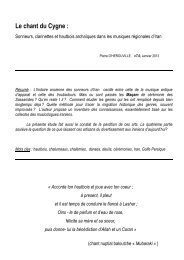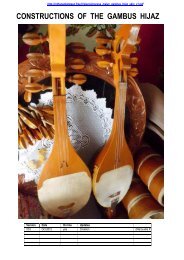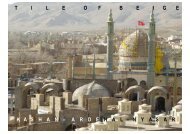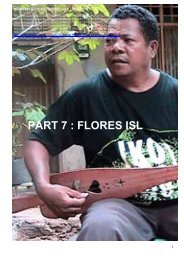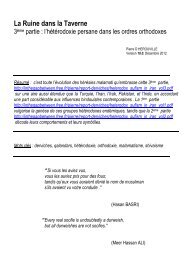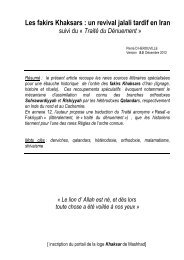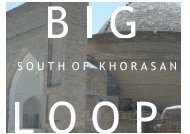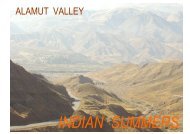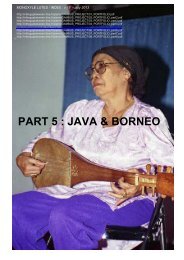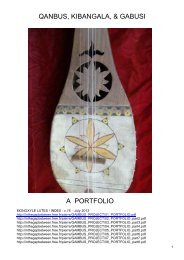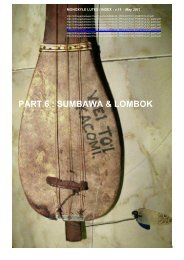process_malay_gambus.. - In the gap between - Free
process_malay_gambus.. - In the gap between - Free
process_malay_gambus.. - In the gap between - Free
Create successful ePaper yourself
Turn your PDF publications into a flip-book with our unique Google optimized e-Paper software.
http://in<strong>the</strong><strong>gap</strong><strong>between</strong>.free.fr/pierre/<strong>process</strong>_<strong>malay</strong>_<strong>gambus</strong>_seludang_wooden_v7.pdf<br />
GAMBUS SELUDANG CONSTRUCTIONS<br />
Version Date On line Updates Writer<br />
V0.0 June 2008 yes Creation dHerouville P.<br />
V4.0 Febr 2011 yes update about Seri Serbang workshop dHerouville P<br />
V5.0 Oct. 2011 yes update about Riau isl workshop dHerouville P<br />
V 3 & 6.0 Jun. 2012 yes More about Mohd Diah Arifin, Kg Rahmat, Johor dHerouville P<br />
V 7.0 Sept. 2012 yes Sorting Gambus Hijaz variants and genres dHerouville P
The Gambus name nowadays took an unexplicit acception in <strong>the</strong> indonesian archipelago, since <strong>the</strong> word<br />
became synonymous of “middle east-like lute” <strong>the</strong>re. If <strong>the</strong> word is certainly rooted in <strong>the</strong> Yemeni name “Qanbus”,<br />
according to <strong>the</strong> homonymous lute of <strong>the</strong> Sana’an plateau, for sure, every current <strong>In</strong>donesian avatars now embody<br />
various designs. Three main categories of Gambus coexist Malaysia and <strong>In</strong>donesia:<br />
1. - Gambus Hijaz, a monoxyle, long necked lute , mostly according summary informations . Also known<br />
<strong>the</strong>re as Gambus Melayu (<strong>malay</strong>, incl. Kutai tribesmen in south Kalimantan), Panting (Benjmarsin/Banjarmasin, and,<br />
actually everywhere in Kalimantan) , Gita Nangka (Sin<strong>gap</strong>ore), Gambus Seludang , Gambus Perahu , Gambus<br />
Biawak , Gambus Palembang The instrument is now rare and hardly survives reportedly in Johor state,<br />
Sarawak (near Kuching), Sabah (Semporna, and seldom in Papar, Bongawan), Kalimantan (panting music<br />
in Benjmarsin /Banjarmasin) and various districts of Sumatra districts : Bengkalis, Penyengat, Jambi, & Medan.<br />
Considering its extinction in Malacca and Johore, such shape of Gambus was significantly preserved,<br />
indeed:<br />
-- in Borneo (Kalimantan, Brunei, Sarawak and Sabah)<br />
-- in Eastern Sumatra (Bangka isl, Kayu Agung, Lampung)<br />
- in West Sumatra (mostly Medan: province of Aceh)<br />
-- in <strong>the</strong> path of Malacca (Penyagat, Riau)<br />
<strong>In</strong>deed, some few alternate skin-boarded, “Gambus” named, avatars are also still observable as far<br />
as Makassar (Sulawezi), Brunei, Moluccas, East Kalimantan, and Nusa Tengarra Barat. But that design is<br />
clearly under extinction all over<strong>the</strong>re, or substituted by alternate, wooden covered designs.<br />
Now under extinction, Gambus Hijaz lute is still accompanying Zapin / Jepen dance (Ar. Zafin, a dance<br />
genre from Hadhramawt, still widespread in Sawt-like sessions in <strong>the</strong> Gulf countries) namely <strong>the</strong> local<br />
Hamdolok dance – Batu Pahat – and <strong>the</strong> Zapin Banjar - Kalimantan-. Considering that Johore’s Ghazal<br />
music now substituted Gambus Hijaz lute with oud in continental Malaysia, <strong>the</strong> relevant regional musical<br />
avatars for Zafin & Gambus Hijaz are nowadays Hamdolok (Batu Pahat) a.k.a. Mudul Luk (Kayu Agung,<br />
east Sumatra) , Tingkilan (Kutai tribesmen, south Kalimantan) and Panting-Banjar ( south Kalimantan and<br />
surroundings of Benjmarsin/Banjarmasin city). The name Banjar echoes obviously “Banjarmasin”, which is an<br />
harbor-city, situated south of Kalimantan. (we describe <strong>the</strong> construction sepretaly in an alternate document<br />
named “Process_<strong>gambus</strong>_hidjaz”)<br />
<strong>In</strong> Kalimantan, strings of <strong>the</strong> Panting lute used to be made of twisted vegetal fibers (haduk hanau ( ijuk )<br />
nenas, bikat, bast or twisted sinali), but nylon strings are now in use. The quantity of string rose from 3 , up to<br />
10. Each string of <strong>the</strong> Panting is reported as a part of 3 choirs, namely:<br />
1. Pangalik: first string/choir, ringing <strong>the</strong> penyisip a.k.a melody.<br />
2. Panggundah or Pangguda second string/choir, a.k.a. constituent indones. paningkah.<br />
3. Agur, that is played as a bass string, or buzz.<br />
2. - Gambus Hadramawt, an oud-like lute. The instrument features <strong>the</strong> conventional glued ribs, or<br />
« arched back » technics, as HILARIAN use to name it. This is famous in peninsular Malaysia as <strong>the</strong><br />
« Gambus Johor », as this is appreciated <strong>the</strong>re still when performing local avatars of <strong>the</strong> Ghazal musical<br />
performance. This can be found still in Johor state, Brunei, Sabah, Java , Sumatra, Madura, Sulu. The<br />
instrument is still much appreciated in Brunei, where this was presumately introduced <strong>the</strong>re much later than<br />
<strong>the</strong> Gambus Hijaz. It seems this is revived <strong>the</strong>re, and still constructed according egyptian design<br />
pattern,mostly for Zapin and Qasida accompaniement.<br />
3. - Bruneian monoxyle Gambus Seludang is a local crossover design family in Brunei and Sabah.<br />
This name « Seludang » is reported by HILARIAN as a former vernacular nickname of <strong>the</strong> Gambus Hijaz ,<br />
but <strong>the</strong> bruneian making technics and organology – obvious specific feature is a 100% wooden soundboard,
GAMBUS KECIL (LAMPUNG, EAST SUMATRA)<br />
The Gambus Kecil, a tiny toy-instrument, contributes to perpetuate <strong>the</strong> Gambus as a popular<br />
instrument in remote areas. Here some snake skin boarded items, as practiced by teenagers in<br />
Lampung.<br />
BRUNEIAN GAMBUS KECIL – BRUNEI<br />
<strong>In</strong> Brunei, <strong>the</strong> Gambus Kecil is <strong>the</strong> low range of <strong>the</strong> playable Gambus Seludang.<br />
(photo unknown webblog)
“GAMBUS MELAYU”, CROSS OVER (RIAU, SUMATRA)<br />
The wooden soundboard proves a later middle-eastern influence, which finally superceded <strong>the</strong><br />
original yemeni design Here <strong>the</strong> traditional band of Khairul ASRAR” (Riau, Sumatra) plays some<br />
crossover lute of Riau’s Gambus Hijaz with oud.<br />
GAMBUS MELAYU” HADHRAMAWT” (SARATOK, SARAWAK)<br />
Some decades ago, oud copy trials had reached a dramatic size. Here <strong>the</strong> maker / player<br />
Penghulu Hamid, Saratok (Sarawak)
eferring vaguely with both existing Gambus Hijaz and Gambus Hadramawt families, but into a new, local<br />
design . The author claims <strong>the</strong> name « Seludang » to root from <strong>the</strong> shape of a local palm sheath, and this<br />
may differentiate it in <strong>the</strong> local vernacular vocabulary of Sabah, as Gambus Hijaz was basically nicknamed<br />
Gambus Biawak in this far territory, as HILARIAN says.<br />
Actually, <strong>the</strong> confusing « Seludang » name presumately suggests this endemic monoxyle<br />
construction may have originated in latter evolutions of local technics, after <strong>the</strong> oud to have been<br />
reintroduced in Brunei.<br />
- The Oud was an obvious feature of <strong>the</strong> Arabs, and still is referred as a picturesque cultural<br />
reference to <strong>the</strong>m, especially for sunni arab-like performances, such as Marawis, Rathib, “Gambus”<br />
congregational meets of <strong>the</strong> Malays ( Sabah, Alam Melayu). Unfortunately, original oud lutes aren’t<br />
available, for example: nei<strong>the</strong>r in Brunei Darussalaam, nor in Sabah, however in a sufficient quantity<br />
and price. Possibly, <strong>the</strong> phenomenon first promoted <strong>the</strong> local construction of some Gambus Hijaz<br />
items (in Brunei: Gambus Biawak), but <strong>the</strong> Selandung Buntal construction, a more reliable<br />
instrument, finally boomed in and out of Brunei from <strong>the</strong> 1990’s.<br />
- A technical opportunity for that change may be <strong>the</strong> outstanding profusion of abunding huge jack trees<br />
and teack trees in Brunei and Sabah.<br />
- The need possibly is rooted in <strong>the</strong> absence of alternate identitary reference among urban<br />
communities in Brunei. The mainstream culture <strong>the</strong>re, possibly reject rainforest tribesmen<br />
backgrounds, and elected urban sunni culture of <strong>the</strong> Malays as a modern pattern.<br />
So, such Gambus construction boomed in Brunei, Papar, Weston and Bongawan, let us focus upon <strong>the</strong> wide<br />
range of so-made lutes :<br />
- Saludang Mayang are narrow boxed instruments, much similar as <strong>the</strong> Gambus Hijaz - i.e. shape<br />
and size- , but <strong>the</strong> soundbard is made of wood indeed. The construction totally merged former<br />
features of <strong>the</strong> Qanbus-like Gambus Biawak, with wooden components of <strong>the</strong> Gambus Seludang<br />
family.<br />
- Saludang Buntal are wider shaped lutes, whose soundox width varies from <strong>the</strong> Mayang’s one<br />
(about 25 cm) up tu a conventional oud’s one. <strong>In</strong> this category both monoxyle construction and 0.80<br />
down-scaled conventional oud lutes, as <strong>the</strong> « «arched back » construction technics survives in Brunei<br />
and Papar, Sabah. Organology speaking, Gambusu lutes from Sunda and Sulawezi are globally very,<br />
very similar. Some feature 4 choirs, some feature 5.<br />
- Gambus Kecil are <strong>the</strong> smallest monoxyle <strong>gambus</strong> in Brunei, much shorter than Saludang<br />
Mayang. As large as a ukulele.<br />
These bruneian monoxyle lutes are being revived in <strong>the</strong> area of Papar, where <strong>the</strong>y are in use for a Zapin<br />
music annual festival.. According to Larry Francis HILARIAN, this is very same as <strong>the</strong> Gambusu design in<br />
Sulawesi.<br />
--------------------------------------------------------------------------------------------------------------------------------------<br />
This document summarizes endemic construction techniques, mostly for<br />
-----------Gambus hadhramawt acc. testimonies in Batu Pahat (Johore coastal province)<br />
-----------Gambus Seludang Mayang and Gambus Seludang Buntal of Sabah (Malaysia) , acc. testimonies<br />
among Bruneian migrants in Papar (Sabah) and Weston (Sabah).<br />
About skin-boarded Gambus lute making, see alternate file<br />
http://in<strong>the</strong><strong>gap</strong><strong>between</strong>.free.fr/pierre/<strong>process</strong>_<strong>malay</strong>_<strong>gambus</strong>_hijaz_skin_v1.pdf
GAMBUS SELUDANG MAYANG (PAPAR, SABAH)<br />
The Gambus Seludang Mayang, a, medium sized, cross over instrument, is very<br />
popular now among bruneian teenagers of Sabah, who used to sort it nowadays with<br />
new vernacular songs.<br />
GAMBUS SELUDANG BUNTAL (PAPAR, SABAH)<br />
Gambus Selandung Buntal by bruneian maker Awang PESAR , Bongawan.
4.<br />
3.<br />
MALAYSIAN GAMBUS - TYPOLOGY<br />
PRODUCTION BY MAKER « PAK MAT », KAMPUNG RAHMAT, BATU PAHAT, JOHOR<br />
1. Gambus Melayu, Batu Pahat 2. Gambus Hadramawt, Batu Pahat<br />
3. Gambus Hadramawt, Batu Pahat, Johor 4. Gambus a.k.a. Saludang Buntal (Borneo design)<br />
1.<br />
2.
MALAYSIAN GAMBUS - TYPOLOGY<br />
1. 2. 3. 4. 5. 6.<br />
1. Gambus Melayu, Bengkalis , 2. Gambus Melayu, Sumatra<br />
3. Gambus Melayu, Batu Pahat, Johor, 4. Gambus Melayu , Brunei<br />
5. Gambus a.k.a. Saludang Buntal, Brunei & Sabah 6. Gambus Kecil, Brunei<br />
(Data by Larry Francis HILARIAN)
fingerboard / Leher<br />
beak / Kepala)<br />
pegs / Telinga<br />
neck / Leher<br />
shoulder / bahu<br />
GAMBUS HADRAMAWT - ORGANOLOGY – VERNACULAR NAMES ( JOHOR, MALAYSIA)<br />
Malay name of <strong>the</strong> components , according to Larry Francis HILARIAN<br />
small rose / Lubang<br />
bunyi)<br />
chest, soundboard /<br />
Muka (face)<br />
bridge / Gertak<br />
body, soundbox / Badan
GAMBUS HADRAMAWT - ORGANOLOGY – VERNACULAR NAMES (MALAYSIA)
BRUNEIAN GAMBUS SELUDANG BUNTAL – OUTER CARVING<br />
The instrument (body +neck + pegbox ) is carved out a huge block of nangka (jack tree) .<br />
Maker Awang PESAR, Seri Serbang, Bongawan, Sabah.<br />
BRUNEIAN GAMBUS SELUDANG BUNTAL – OUTER CARVING<br />
The instrument (body +neck + pegbox ) is carved out a huge block of nangka (jack tree) .<br />
Maker Awang PESAR, Seri Serbang, Bongawan, Sabah.<br />
(photo Melissa WONG webblog)
BRUNEIAN GAMBUS SELUDANG BUNTAL (MONOXYLE) – BODY CARVING<br />
Maker Awang PESAR, Seri Serbang, Bongawan, Sabah.
BRUNEIAN GAMBUS SELUDANG MAYANG (MONOXYLE) – BODY CARVING<br />
Body carving doesn’t seem to be a key factor in bruneian Gambus Seludang. Unlike Gambus<br />
Hijaz, <strong>the</strong> neck is no longer hollowed, and <strong>the</strong> thickness of <strong>the</strong> soundboxes here is up to 20 mm<br />
sized for Gambus Seludang Buntal, and about 10 mm for Gambus Seludang Mayang.<br />
As observed in <strong>the</strong> workshop of Maker Haj Mokti MUHIDDIN in Weston, Beaufort, Sabah.<br />
BRUNEIAN GAMBUS SELUDANG BUNTAL (MONOXYLE) – BODY CARVING<br />
<strong>In</strong> <strong>the</strong> same way , soundbox is hollowed out of <strong>the</strong> same clamped block . Maker checks thickness<br />
with a thickness gauge. And this seems to be much thinner at this alternate Bruneian maker,<br />
namely Awang PESAR, Seri Serbang, Bongawan, Sabah.<br />
(photo Melissa WONG webblog)
BRUNEIAN GAMBUS SELUDANG BUNTAL (MONOXYLE) – BODY CARVING<br />
The box is handcarved with gouge. Average final thickness is about 8 -10 mm .<br />
Maker Awang PESAR, Seri Serbang, Bongawan, Sabah.
BRUNEIAN GAMBUS SELUDANG BUNTAL (MONOXYLE) – CARVING THE PEGBOX<br />
The box is handcarved with gouge. Average final thickness is about 8 -10 mm . Original bruneian item held by<br />
HILARIAN in Sin<strong>gap</strong>ore (insert, left) shows off <strong>the</strong> original technics consisted in hollowing <strong>the</strong> neck as well, that is no<br />
longer done in Papar, Sabah. Maker Awang PESAR, Seri Serbang, Bongawan, Sabah.
GAMBUS HADHRAMAWT (ARCHED BACK) – RIB BENDING<br />
Conventional assembly of <strong>the</strong> soundbox of a arched back Gambus Hadhramawt lute: ribs are kept in water for<br />
several days.<br />
Maker Mohamad Diah ARIFFIN, or “Pak Mat” in Kampung Rahmat, Batu Pahat, Johore state. (picture by web source)
GAMBUS HADHRAMAWT (ARCHED BACK) – RIB BENDING<br />
Conventional assembly of <strong>the</strong> soundbox of a arched back Gambus Hadhramawt lute:<br />
Assistant of “Pak Mat” in Kampung Rahmat, Batu Pahat, Johore state. (picture by web source)
GAMBUS SELUDANG BUNTAL – ALTERNATE TECHNICS : ARCHED BACK<br />
Maker Hasan BIN OTHMAN, Kampung Parit Hailam, Batu Pahat, (Johor), while training 3 young<br />
followers , early 2000’s : Muhd Ridhuan Abdul ZATEH (26), Abdullah Muhd RIZAL (23) and Abdul<br />
Rashid Iskandar Abdul RANI (21). (Syed Umar Rariff, Johorbuzz)<br />
BRUNEIAN GAMBUS SELUDANG BUNTAL – ALTERNATE TECHNICS : ARCHED BACK<br />
This technic is reminiscent with <strong>the</strong> conventional making of <strong>the</strong> Oud, but this is about 80 % downscaled<br />
oud. Egyptian patterns were taught in Brunei. Maker Awang PESAR, Seri Serbang,<br />
Bongawan, Sabah.
GAMBUS HADHRAMAWT (ARCHED BACK) – BODY ASSEMBLYING<br />
Conventional assembly of <strong>the</strong> soundbox of a arched back Gambus Hadhramawt lute: lutemakers are fixing <strong>the</strong> first rib on<br />
<strong>the</strong> mould. Foreground : <strong>the</strong> related clamps.<br />
Maker Mohamad Diah ARIFFIN, or “Pak Mat” in Kampung Rahmat, Batu Pahat, Johore state. (picture by Kratfung Malaysia)
GAMBUS HADHRAMAWT (ARCHED BACK) – BODY ASSEMBLYING<br />
Conventional assembly of <strong>the</strong> soundbox of a arched back Gambus Hadhramawt lute.<br />
Maker Mohamad Diah ARIFFIN, or “Pak Mat” in Kg Rahmat, Batu Pahat, Johore. (picture by web source)
GAMBUS SELUDANG BUNTAL (ARCHED BACK) – BODY ASSEMBLYING<br />
Soundbox assembly of a arched back Gambus Hadhramawt Buntal lute: lutemakers are<br />
clamping rib on <strong>the</strong> mould. Maker Mohamad Diah ARIFFIN, or “Pak Mat” in KG, Rahmat,<br />
Batu Pahat, Johore state. (picture by web source)<br />
Soundbox assembly of a arched back Gambus Hadhramawt -. Mohamad Diah ARIFFIN, KG<br />
Rahmat, Batu Pahat, Johore state. (picture by web source)
GAMBUS SELUDANG BUNTAL (ARCHED BACK) – BODY ASSEMBLYING<br />
Maker Mohamad Diah ARIFFIN, or “Pak Mat” in Kampung Rahmat, Batu Pahat, Johore state. Clamps are<br />
holding outter ribs of a Gambus Hadramawt soundboard (picture by unknown web source)
BRUNEIAN GAMBUS SELUDANG BUNTAL (ARCHED BACK) – ORNAMENTATIONS<br />
Back to <strong>the</strong> egyptian « arched back » technics : this 80 % scaled down oud soundbox is madeof glued , bowed<br />
ribs. The maker masterizes this pattern and demonstrate his ability by alternate rib width and colors, that<br />
suggests he shapes ribs with two complementary patterns. Wood incrustations in <strong>the</strong> rear part of <strong>the</strong> neck<br />
demonstrates a similar skill. Accoustic speaking, bass rendering is unfortunately defective. The instrument<br />
doesn t sound as loud as this should, as <strong>the</strong> soundbox may not be deep enough, I guess. Maker Awang<br />
PESAR, Seri Serbang, Bongawan, Sabah.
1.<br />
GAMBUS HADHRAMAWT – TOOLBOX FOR RIB BOWING (OUD –LIKE BODY)<br />
4.<br />
1.<br />
7.<br />
1. Head patterns for shoulder 2. Rose-shaped outlet 3. Neck under preparation<br />
4. Pear-shape pattern 5. Neck Pattern 6.Clamps 7. Axe<br />
Toolbox of maker Hasan BIN OTHMAN, Batu Pahat, Johor State.<br />
5.<br />
2.<br />
6.<br />
3.<br />
1.
BRUNEIAN GAMBUS SELUDANG BUNTAL – PEGBOX PATTERN<br />
According to HILARIAN’s pHD, rise of pegbox / head ornamentations is recent in Brunei and peninsular<br />
Malaysia. This is rooted in <strong>the</strong> indonesian technics of <strong>the</strong> Ganmbus Hijaz. Maker Awang PESAR, Seri<br />
Serbang, Bongawan, Sabah.<br />
« The <strong>gambus</strong> Melayu peg-box head from <strong>In</strong>donesia differs from head in east <strong>malay</strong>sia, peninsular Malaysia and Brunei, in which <strong>the</strong>y<br />
usually simple , undecorated peg-box head designs. The indonesian <strong>gambus</strong> melayu ‘s pegbox head often shows some symbolic<br />
representation of birds, flowers or animal heads. These are important mythological representatios. Having <strong>the</strong> pegbox head decoratively carved<br />
as animals, birds or flower seens to be a recent morphological developpment. The indonesian <strong>gambus</strong> melayu types seem to have a narrower<br />
and longer neck or fingerboard tapering from <strong>the</strong> belly to <strong>the</strong> pegbox…» (Larry francis HILARIAN)
BRUNEIAN GAMBUS SELUDANG BUNTAL (MONOXYLE) – ALTERNATE PEGBOX DESIGNS<br />
Left : <strong>the</strong> arched back pegbox by Maker Awang PESAR , Bongawan, Sabah. The 10<br />
stringed pegbox cover is upside down. Although this design is compatible with <strong>the</strong><br />
monoxyle carving <strong>process</strong>, setting pegs is uncomfortable as <strong>the</strong>y are unseen.<br />
Right : An avatar of <strong>the</strong> original oud pegbox design (here 8 stringed) and <strong>the</strong> neck is<br />
not hollowed. The wooden bird is roughly glued on <strong>the</strong> head. As its soundboard is<br />
unproperly streng<strong>the</strong>ned, this is slightly bended inwards. Sounds great. Made by Awang<br />
PESAR , Bongawan, Sabah.<br />
BRUNEIAN GAMBUS SELUDANG BUNTAL (MONOXYLE) – ALTERNATE PEGBOX DESIGNS<br />
A sub-variant of arched back pegbox by Maker Awang PESAR , Bongawan, Sabah.<br />
Pegbox cover is upside down but carved bird was added indeed. Here featured on 2<br />
giant items for exhibition purpose in Tourism Exhibition Board, K.Kinabalu, Sabah.
BRUNEIAN GAMBUS SELUDANG – MORPHOLOGY BY SIZE AND CHOIRS<br />
GAMBUS SELUDANG MAYANG GAMBUS SELUDANG BUNTAL<br />
1. Narrow soundboard (30 cm max) 2. Wider Soundboard (30 to 40 cm)<br />
4, up to 5 stringed choirs 5 stringed choirs<br />
« open » pegbox « upside down » pegbox<br />
1-2 rose outlet in central position 3 rose outlets<br />
2<br />
1<br />
1<br />
The width of <strong>the</strong> soundboard is a guideline for determining quantity of choirs and neck width. The « top-open »<br />
pegbox design is <strong>the</strong> favourite for 4 stringed instruments, but fit for 5 choirs as well..<br />
The « upside down» pegbox seems more appropriate with <strong>the</strong> narrow, 4-5 choirs lute, as wider Gambus<br />
Selundang Buntal style automatically evoke middle eastern patterns ( 5 choirs, 3 roses) . Maker may seek for<br />
homogeneousness in style, by associating <strong>the</strong>m so.<br />
2<br />
2
BRUNEIAN GAMBUS SELUDANG BUNTAL (ARCHED BACK) – ALTERNATE PEGBOX DESIGNS<br />
Here <strong>the</strong> open design of <strong>the</strong> monoxyle Seludang Buntal is applied on a « arched back » scaled down oud . The<br />
shorter, straight pegbox differentiates this with middle-eastern ouds. Maker Awang PESAR, Seri Serbang,<br />
Bongawan, Sabah.
BRUNEIAN GAMBUS SELUDANG BUNTAL – SHAPING SOUNDBOARD<br />
Design pattern for outer shaping of <strong>the</strong> soundboard, here illustrated on <strong>the</strong> machining track of <strong>the</strong> electric<br />
sew. Maker Awang PESAR, Seri Serbang, Bongawan, Sabah<br />
GAMBUS HADRAMAWT – SHAPING SOUNDBOARD<br />
Sawing a soundboard of a Gambus Hadhramawt.<br />
Mohamad Diah ARIFFIN, Batu Pahat, Johore state. (picture by web source)
BRUNEIAN GAMBUS SELUDANG (MONOXYLE) – ALTERNATE SOUNDBOARD STYLES<br />
Left : A 5 stringed choirs Gambus Seludang Buntal. The roses are glued and this<br />
mentions <strong>the</strong> capitals of <strong>the</strong> workshop name (KrafTanG) of Awang PESAR, Bongawan.<br />
Right : <strong>In</strong> size and shape, this 4 stringed choirs Gambus Seludang is very near to <strong>the</strong><br />
Mayang size, despite his unexpected depth (150 mm). Tiny sound outlet is situated in<br />
<strong>the</strong> low center. Ornamentations evoke tribal heritage of Sabah. Awg PESAR,<br />
Bongawan<br />
GAMBUS HADRAMAWT– STRENGHTENING THE SOUNDBOARD<br />
Strenghtening a soundboard of a Gambus Hadhramawt.<br />
Mohamad Diah ARIFFIN, Kampung Rahmat, Batu Pahat, Johore state. (picture by web source)
MAKER MOH’D DIAH ARIFFIN / KAMPUNG RAHMAT / BATU PAHAT, JOHOR<br />
Maker Mohamad Diah ARIFFIN, or “Pak Mat” in Kampung Rahmat, Batu Pahat, Johore state. Finishing leading edge of<br />
a Gambus Hadramawt soundboard (picture by unknown web source)
BRUNEIAN GAMBUS SELUDANG BUNTAL – DECORATING SOUNDBOARD & ROSES<br />
This huge scraped soundboard shows off how wide are <strong>the</strong> largest Selundang Buntal types. The condition of<br />
<strong>the</strong> pinewood board suggests this has been removed out of an existing instrument for substitution.<br />
Astoundingly, this didn t feature any additional beams for strength below.<br />
Background center : Design pattern for outer shaping of <strong>the</strong> soundboard, here illustrated on <strong>the</strong> machining<br />
track of <strong>the</strong> electric sew. Maker Awang PESAR, Seri Serbang, Bongawan, Sabah.
GAMBUSU (SUNDA)<br />
Gambusu from Sunda Isl, as now shown in musee Branly storeage, paris (Picture www.museebranly.fr.)<br />
GAMBUS HADHRAMAWT– SHAPING THE ROSE<br />
Shaping <strong>the</strong> rose out of a thin woodboard. Mohamad Diah ARIFFIN, Kampung Rahmat, Batu Pahat,<br />
Johore state. (picture by web source)
MAKER HAJJ MOKTI MUHIDDIN , WESTON, SABAH<br />
Gambus Seludang Buntal by bruneian maker Hajj Mokti MUHIDDIN (Weston, Sabah) are decorated with a<br />
very modern stylized painting. However <strong>the</strong>y are very similar with <strong>the</strong> production by Awang PESAR (Papar,<br />
Sabah) . Both produce <strong>the</strong> same typical, arched-back, closed pegbox, indeed. (Weston info webblog)
MAKER PENGHULU HAMID - SARATOK, SARAWAK<br />
Penghulu HAMID, storing Oud replicas at his place, satarok, Sarawak .<br />
MAKER HASAN BIN OTHMAN - NEAR BATU PAHAT, JOHOR<br />
Hasan Bin Othman was held as <strong>the</strong> least vintage maker in activity, until his nephew and Pak Mat took over <strong>the</strong> job.
GAMBUS SELUDANG MAYANG (PAPAR, SABAH)<br />
Fauziah “GAMBUS” (Sabah), a local celebrity of Bruneian descent, promoted <strong>the</strong> popular Gambus<br />
Seludang Mayang lute by playing, among o<strong>the</strong>rs, that stylized Gambus Seludang Seludang<br />
BRUNEIAN GAMBUS BUNTAL - ZAPIN FESTIVAL IN PAPAR, SABAH<br />
The “Pesta Gambus” festival of Papar used to highlight bruneians outsiders in Gambus Buntal playing. The<br />
rose is carved in <strong>the</strong> soundboard itself. (Picture MySabah.com)
MAKER AWANG PESAR - SRI SERBANG, BONGAWAN, SABAH<br />
Awang Pesar ‘ here tuniing this amazingly decorated Gambus Seludang Mayang 2008. This example is now held<br />
by <strong>the</strong> author. Awang Pesar, Seri Serbang, Bengawan; Sabah.<br />
BRUNEIAN GAMBUS BUNTAL - SERI SERBANG, PAPAR, SABAH<br />
Maker Awang Pesar is highly prolific since <strong>the</strong> 1990’s, and much in demand in <strong>the</strong> bruneian community. Here<br />
demonstrating his instruments for Melissa WONG. Awang Pesar, Seri Serbang, Bengawan; Sabah.<br />
(photo: Melissa WONG webblog)
FADZIL AHMAD / SRI MARANI, MUAR, JOHOR<br />
Fadzil AHMAD , a major player / composer of <strong>malay</strong> Ghazal in Johor State until <strong>the</strong> late 1990’s<br />
Fadzil AHMAD , a major player / composer of <strong>malay</strong> Ghazal in Johor State until <strong>the</strong> late 1990’s
FADZIL AHMAD / SRI MARANI, MUAR, JOHOR<br />
Fadzil AHMAD ,when he was young. a major player / composer of <strong>malay</strong> Ghazal in Johor State until <strong>the</strong> late 1990’s
MAKER MOH’D DIAH ARIFFIN / BATU PAHAT, JOHOR<br />
Exhibition of <strong>the</strong> Gambus lutes by Maker Mohamad Diah ARIFFIN, or “Pak Mat” in Batu Pahat, Johore state. (picture by<br />
unknown websource)
MAKER MOH’D DIAH ARIFFIN / KAMPUNG RAHMAT /BATU PAHAT, JOHOR<br />
Maker Mohamad Diah ARIFFIN, or “Pak Mat” in Batu Pahat, Johore state. <strong>In</strong> <strong>the</strong> foreground, <strong>the</strong> distinction<br />
<strong>between</strong> Gambus Hadramawt (right) and <strong>the</strong> Gambus Seludang Buntal is obvious (left) (picture by Kratfung<br />
Malaysia)<br />
BIBLIOGRAPHY<br />
Abdoun, Seifed-Din Shehadeh, « The oud, <strong>the</strong> king of arabic instruments », ISBN ???? , Arabila production Publ., 100 p., Washington DC(USA) / Irbid<br />
(Jordan), 1996. ( i)<br />
Ashari, Mohammad, interview, lutemaker. Firdowsi Bazaar, Bandar Qeshm , Hormuzgan, 2007<br />
Hilarian, Larry Francis, « The Gambus lute of <strong>the</strong> <strong>malay</strong> World », pH D. , Nanyang Technical University of Sin<strong>gap</strong>ore, Sin<strong>gap</strong>ore, 2004. (e)<br />
Hilarian, Larry Francis,<br />
2005a « The <strong>gambus</strong> (lutes) of <strong>the</strong> <strong>malay</strong> World : its origins and significance in Zapin Music », Nanyang Technical University of Sin<strong>gap</strong>ore,<br />
Sin<strong>gap</strong>ore, 2005.<br />
2005b « The structure and development of <strong>the</strong> <strong>gambus</strong> (<strong>malay</strong> lute) » in <strong>the</strong> Galpin society Journal # LVIII , Malaysia?, 2005<br />
2006 « The folk lute (<strong>gambus</strong>) and its symbolic expression in <strong>malay</strong> muslim culture » in Folklore studies # XXIII , <strong>In</strong>stitute of lituanian literature and<br />
folklore, Vilnius<br />
2007 « The migration of Lute type instruments to <strong>the</strong> Malay Muslim World » in Congrés des musiques dans le monde l ‘Islam, Assilah, August 8-13,<br />
2007. world<br />
2008 « Understanding <strong>malay</strong> music <strong>the</strong>ory through <strong>the</strong> performance of <strong>the</strong> <strong>malay</strong> lute (<strong>gambus</strong>) » in Music Journal # 4 , Malaysia, 2008.<br />
Nariman, Mansur, « The method of Playing <strong>the</strong> Lute », Soroush Publ, ISBN 964-376-291-2, Tehran, 2005. Iran. ( g )



